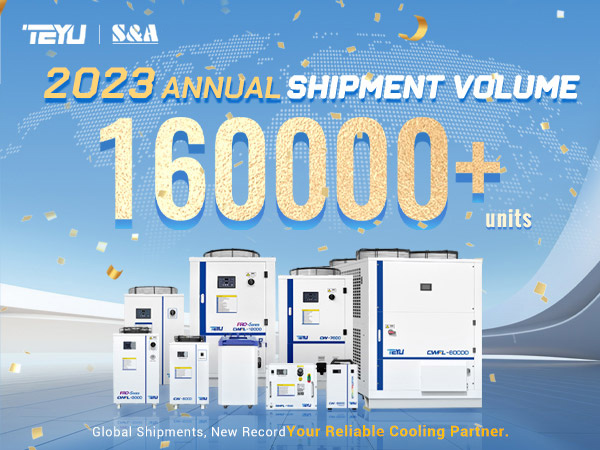TEYU Chiller remains committed to staying at the forefront of laser cooling technology. We continuously monitor industry trends and innovations in blue and green lasers, driving technological advancements to foster new productivity and accelerate the production of innovative chillers to meet the evolving cooling requirements of the laser industry.
Laser welding is an emerging high-efficiency processing technique. The process of laser machining is the result of the interaction between a specific beam of energy and the material. Materials are generally categorized into metals and non-metals. Metal materials include steel, iron, copper, aluminum, and their related alloys, while non-metal materials include glass, wood, plastic, fabric, and brittle materials. Laser manufacturing is applied in many industries, but so far, its application is primarily within these material categories.
The Laser Industry Needs to Strengthen Research On Material Properties
In China, the rapid development of the laser industry is driven by a large demand for applications. However, most laser equipment manufacturers focus mainly on the interaction between the laser beam and mechanical components, with some considering equipment automation. There is a lack of research on materials, such as determining which beam parameters are suitable for different materials. This gap in research means that some companies develop new equipment but cannot explore its new applications. Many laser companies have optical and mechanical engineers but few material science engineers, highlighting the urgent need for more research into material properties.
The High Reflectivity of Copper Promotes the Development of Green And Blue Laser Technology
In metal materials, laser processing of steel and iron has been well-explored. However, processing high-reflectivity materials, especially copper and aluminum, is still being explored. Copper is widely used in cables, home appliances, consumer electronics, electrical equipment, electronic components, and batteries due to its excellent thermal and electrical conductivity. Despite many years of effort, laser technology has struggled to process copper due to its properties.
First, copper has a high reflectivity, with a 90% reflectivity rate for the common 1064 nm infrared laser. Secondly, copper’s excellent thermal conductivity causes heat to dissipate quickly, making it difficult to achieve the desired processing effect. Thirdly, higher-power lasers are required for processing, which can lead to copper deformation. Even if welding is completed, defects and incomplete welds are common.
After years of exploration, it has been found that lasers with shorter wavelengths, such as green and blue lasers, are more suitable for welding copper. This has driven the development of green and blue laser technology.
Switching from infrared lasers to green lasers with a 532 nm wavelength significantly reduces the reflectivity. The 532 nm wavelength laser allows continuous coupling of the laser beam to the copper material, stabilizing the welding process. The welding effect on copper with a 532 nm laser is comparable to that of a 1064 nm laser on steel.
In China, the commercial power of green lasers has reached 500 watts, while internationally it has reached 3000 watts. The welding effect is particularly significant in lithium battery components. In recent years, green laser welding of copper, especially in the new energy industry, has become a highlight.
Currently, a Chinese company has successfully developed a fully fiber-coupled green laser with a power output of 1000 watts, greatly expanding the potential applications for copper welding. The product is well-received in the market.
In the past three years, new blue laser technology has gained industry attention. Blue lasers, with a wavelength of around 450 nm, fall between ultraviolet and green lasers. Blue laser absorption on copper is better than green laser, reducing the reflectivity to below 35%.
Blue laser welding can be used for both thermal conduction welding and deep penetration welding, achieving “spatter-free welding” and reducing weld porosity. Besides improving quality, blue laser welding of copper also offers significant speed advantages, being at least five times faster than infrared laser welding. The effect achieved with a 3000-watt infrared laser can be accomplished with a 500-watt blue laser, significantly saving energy and electricity.

Laser Manufacturers that Develop Blue Lasers
Leading manufacturers of blue lasers include Laserline, Nuburu, United Winners, BWT, and Han's Laser. Currently, blue lasers adopt the fiber-coupled semiconductor technology route, which lags slightly in energy density. Therefore, some companies have developed dual-beam composite welding to achieve better copper welding effects. Dual-beam welding involves simultaneously using blue laser beams and infrared laser beams for copper welding, with carefully adjusted relative positions of the two beam spots to solve high reflectivity issues while ensuring sufficient energy density.
Understanding material properties is crucial when applying or developing laser technologies. Whether using blue or green lasers, both can enhance copper's absorption of lasers, though high-power blue and green lasers are currently costly. It is believed that as processing techniques mature and the operational costs of blue or green lasers appropriately decrease, the market demand will truly surge.
Efficient Cooling for Blue and Green Lasers
Blue and green lasers generate significant heat during operation, necessitating robust cooling solutions. TEYU Chiller, a leading chiller manufacturer with 22 years of experience, provides tailored cooling solutions for a wide range of industrial and laser applications. Our CWFL series water chillers are specifically designed to offer precise and efficient cooling for fiber laser systems, including those employed in blue and green laser processes. By understanding the unique cooling demands of laser equipment, we deliver powerful and reliable chillers to enhance productivity and safeguard equipment.
TEYU Chiller remains committed to staying at the forefront of laser cooling technology. We continuously monitor industry trends and innovations in blue and green lasers, driving technological advancements to foster new productivity and accelerate the production of innovative chillers to meet the evolving cooling requirements of the laser industry.

We're here for you when you need us.
Please complete the form to contact us, and we'll be happy to help you.
Copyright © 2025 TEYU S&A Chiller - All Rights Reserved.